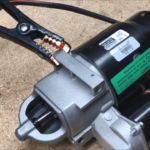Flattening a tire may seem like a harmless prank, but it can have serious consequences if done incorrectly or without proper safety precautions.
Whether you need to flatten a tire for a practical reason, such as to replace it, or you’re looking to play a prank on someone, it’s important to know the proper steps to take to do it safely and effectively.
Knowing how to flatten a tire can come in handy in various situations, such as when you need to replace a tire, or when you need to immobilize a vehicle temporarily.
However, it’s important to keep safety in mind at all times. Flattening a tire can be dangerous if not done properly, and can result in serious injury or damage to the vehicle.
Therefore, it’s crucial to follow the proper steps to ensure that the process is done safely and effectively. In this article, we will cover the necessary steps to flatten a tire safely and effectively.
Understanding Tire Anatomy

Tire Components
To understand how to flatten a tire, it’s important to first understand the different components that make up a tire. A tire is made up of several layers, including the tread, sidewall, and bead.
The tread is the part of the tire that makes contact with the road. It’s designed to provide traction and grip, and it’s made up of a series of grooves and channels that help to channel water away from the tire’s surface.
The sidewall is the part of the tire that connects the tread to the bead. It’s also responsible for providing some of the tire’s structural support, as well as protecting it from damage.
The bead is the part of the tire that sits on the rim of the wheel. It’s made up of a steel wire that’s coated in rubber, and it’s responsible for helping to keep the tire in place on the wheel.
Tire Maintenance
Proper tire maintenance is essential for keeping your tires in good condition and reducing the risk of a flat. This includes regularly checking the tire pressure, inspecting the tread for wear and damage, and making sure that the tires are properly aligned and balanced.
It’s also important to avoid driving on tires that are underinflated or overinflated, as this can lead to uneven wear and potentially cause a blowout. Additionally, it’s important to avoid driving on tires that are damaged or have punctures, as this can cause further damage and increase the risk of a flat.
Overall, understanding the anatomy of a tire and properly maintaining it can help to reduce the risk of a flat and keep you safe on the road.
Preparation Steps

Before attempting to flatten a tire, there are a few preparation steps that need to be taken to ensure safety and efficiency. The following subsections detail the necessary precautions and tools needed to successfully flatten a tire.
Safety Measures
First and foremost, safety should be a top priority when dealing with a flat tire. It is important to park the vehicle on a level surface and engage the parking brake to prevent the vehicle from rolling. Additionally, hazard lights should be turned on to alert other drivers of the situation.
It is recommended to keep a cell phone on hand in case of emergencies. If the tire cannot be safely flattened, it may be necessary to call for roadside assistance.
Required Tools
To flatten a tire, a few tools are necessary. A jack is needed to lift the vehicle off the ground, allowing for the tire to be removed. A lug wrench is needed to loosen the lug nuts on the tire. A tire pressure gauge is needed to ensure proper tire pressure after the tire has been flattened.
It is important to note that the spare tire should also be on hand in case the flattened tire cannot be repaired. It is recommended to check the spare tire’s pressure periodically to ensure it is ready for use.
Methods to Flatten a Tire

Flattening a tire intentionally or unintentionally can be a risky and potentially dangerous act. However, there are a few methods that can be used to flatten a tire. In this section, we will discuss some of these methods.
Puncture Technique
One of the easiest ways to flatten a tire is by puncturing it with a sharp object such as a nail or a screwdriver. To do this, the sharp object is inserted into the tire until the air starts to escape. This method is not recommended as it can cause a sudden blowout and can be potentially dangerous.
Valve Stem Removal
Another way to flatten a tire is by removing the valve stem. The valve stem is the small metal pin that is located in the center of the tire valve. To remove the valve stem, one needs to use a pair of needle-nose pliers to secure the metal pin and turn it counterclockwise to detach it. The tire will deflate quickly when the pin is completely detached from the valve stem.
Slashing Tires
Slashing tires is another method that can be used to flatten a tire. This involves using a sharp object such as a knife to cut the tire. This method is not recommended as it can cause a sudden blowout and can be potentially dangerous.
It is important to note that intentionally flattening a tire is illegal and can result in fines or even imprisonment. It can also cause damage to the vehicle and put the safety of the driver and other road users at risk. Therefore, it is important to take proper care of the tires and ensure that they are properly inflated at all times.
Post-Deflation Steps

Once a tire has been deflated, there are a few steps that need to be taken to ensure that the vehicle is safe to drive and that the tire can be repaired or replaced.
Tire Repair
If the tire has been punctured or damaged, it may be possible to repair it. However, it is important to note that not all tires can be repaired and that repairing a tire may only be a temporary solution.
To repair a tire, first, locate the puncture or damage. Then, clean the area around the puncture or damage with a wire brush and apply a patch or plug to seal the hole. It is recommended to use a tire repair kit, which typically includes all the necessary tools and materials.
Changing a Flat Tire
If the tire cannot be repaired, it will need to be replaced. To change a flat tire, first, locate the spare tire and the necessary tools, which are typically stored in the trunk or under the vehicle.
Then, loosen the lug nuts on the flat tire using a lug wrench. Next, use a jack to lift the vehicle off the ground and remove the lug nuts and the flat tire. Finally, install the spare tire and tighten the lug nuts in a star pattern.
It is important to note that driving on an underinflated or flat tire can cause damage to the tire and the vehicle, and can also be dangerous. Therefore, it is recommended to inflate or replace the tire as soon as possible.
Tire Inflator
To inflate a tire, a tire inflator can be used. A tire inflator is a device that is used to fill tires with air. It can be powered by electricity, a battery, or a car’s cigarette lighter. To use a tire inflator, first, attach it to the valve stem of the tire. Then, turn it on and wait for the tire to reach the desired pressure.
It is important to note that overinflating a tire can be just as dangerous as underinflating it. Therefore, it is recommended to check the tire pressure regularly and to inflate the tire to the manufacturer’s recommended pressure.
Legal and Ethical Considerations
Flattening a tire is not only a safety hazard but also an illegal and unethical act. It can cause harm to the driver, passengers, and other road users. Therefore, it is important to consider the legal and ethical implications before attempting to flatten a tire.
Legal Implications
Flattening a tire without the owner’s consent is a criminal offense in most states. It can result in hefty fines, imprisonment, or both.
For instance, in California, a person who intentionally damages another person’s vehicle can be charged with a misdemeanor or a felony, depending on the extent of the damage. The punishment can include a fine of up to $10,000 and/or imprisonment for up to three years.
Moreover, if the person who flattened the tire is caught, they may be required to pay for the damages caused. This can include the cost of repairing or replacing the tire, as well as any other damages caused by the act.
Ethical Implications
Flattening a tire without the owner’s consent is also an unethical act. It can cause inconvenience, delay, and financial burden to the owner. Moreover, it can put the driver and passengers at risk of accidents, especially if they are traveling at high speeds.
Furthermore, flattening a tire can also be considered a form of vandalism. It can damage the vehicle and cause emotional distress to the owner. In some cases, it can also be considered a hate crime if it is done with the intent to harm a particular individual or group.
Final Thoughts
Flattening a tire intentionally is not a recommended practice as it can be dangerous and illegal. However, in certain situations, such as when a tire is damaged beyond repair, it may be necessary to flatten it to prevent further damage or injury.
If you need to flatten a tire, the easiest and safest way is to use a tire deflator tool. These tools can be purchased at most auto parts stores and are relatively inexpensive. Simply attach the tool to the valve stem and twist the handle to release the air from the tire.
Alternatively, if you do not have a tire deflator tool, you can use a small object such as a screwdriver or pen to depress the valve stem and release the air. However, this method can be more difficult and may damage the valve stem if not done correctly.
It is important to note that intentionally flattening a tire can be illegal in some areas and can result in fines or other penalties. Always check local laws and regulations before attempting to flatten a tire.
Overall, it is best to avoid intentionally flattening a tire and instead seek professional assistance if a tire is damaged or needs to be replaced.




![How to Flatten a Tire Quickly and Safely [Legal] how to flatten a tire quickly and safely](https://roadsumo.com/wp-content/uploads/2022/05/how-to-flatten-a-tire-quickly-and-safely-150x150.jpg)

![How Much Is a Used Tire? Average Cost of Used Tires [Guide] how much is a used tire](https://roadsumo.com/wp-content/uploads/2022/03/how-much-is-a-used-tire-150x150.jpg)


![Read more about the article SCS Ray10 Wheels [Specs and Review]](https://roadsumo.com/wp-content/uploads/2022/12/SCS-Ray10-wheels-300x200.jpg)